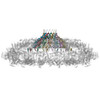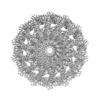+ Open data
Open data
- Basic information
Basic information
| Entry | Database: EMDB / ID: EMD-20020 | |||||||||||||||
|---|---|---|---|---|---|---|---|---|---|---|---|---|---|---|---|---|
| Title | Reconstruction of a T4SS OMCC | |||||||||||||||
 Map data Map data | C14 Reconstruction of T4SS OMCC | |||||||||||||||
 Sample Sample |
| |||||||||||||||
 Keywords Keywords | T4SS / Secretion / H. pylori / TRANSLOCASE | |||||||||||||||
| Function / homology |  Function and homology information Function and homology informationouter membrane / protein secretion / membrane => GO:0016020 / membrane / plasma membrane Similarity search - Function | |||||||||||||||
| Biological species |  | |||||||||||||||
| Method | single particle reconstruction / cryo EM / Resolution: 3.8 Å | |||||||||||||||
 Authors Authors | Chung JM / Sheedlo MJ | |||||||||||||||
| Funding support |  United States, 4 items United States, 4 items
| |||||||||||||||
 Citation Citation |  Journal: Elife / Year: 2019 Journal: Elife / Year: 2019Title: Structure of the Cag type IV secretion system. Authors: Jeong Min Chung / Michael J Sheedlo / Anne M Campbell / Neha Sawhney / Arwen E Frick-Cheng / Dana Borden Lacy / Timothy L Cover / Melanie D Ohi /  Abstract: Bacterial type IV secretion systems (T4SSs) are molecular machines that can mediate interbacterial DNA transfer through conjugation and delivery of effector molecules into host cells. The Cag T4SS ...Bacterial type IV secretion systems (T4SSs) are molecular machines that can mediate interbacterial DNA transfer through conjugation and delivery of effector molecules into host cells. The Cag T4SS translocates CagA, a bacterial oncoprotein, into gastric cells, contributing to gastric cancer pathogenesis. We report the structure of a membrane-spanning Cag T4SS assembly, which we describe as three sub-assemblies: a 14-fold symmetric outer membrane core complex (OMCC), 17-fold symmetric periplasmic ring complex (PRC), and central stalk. Features that differ markedly from those of prototypical T4SSs include an expanded OMCC and unexpected symmetry mismatch between the OMCC and PRC. This structure is one of the largest bacterial secretion system assemblies ever reported and illustrates the remarkable structural diversity that exists among bacterial T4SSs. | |||||||||||||||
| History |
|
- Structure visualization
Structure visualization
| Movie |
 Movie viewer Movie viewer |
|---|---|
| Structure viewer | EM map:  SurfView SurfView Molmil Molmil Jmol/JSmol Jmol/JSmol |
| Supplemental images |
- Downloads & links
Downloads & links
-EMDB archive
| Map data |  emd_20020.map.gz emd_20020.map.gz | 471.6 MB |  EMDB map data format EMDB map data format | |
|---|---|---|---|---|
| Header (meta data) |  emd-20020-v30.xml emd-20020-v30.xml emd-20020.xml emd-20020.xml | 13.6 KB 13.6 KB | Display Display |  EMDB header EMDB header |
| FSC (resolution estimation) |  emd_20020_fsc.xml emd_20020_fsc.xml | 17.9 KB | Display |  FSC data file FSC data file |
| Images |  emd_20020.png emd_20020.png | 68.5 KB | ||
| Filedesc metadata |  emd-20020.cif.gz emd-20020.cif.gz | 6.2 KB | ||
| Archive directory |  http://ftp.pdbj.org/pub/emdb/structures/EMD-20020 http://ftp.pdbj.org/pub/emdb/structures/EMD-20020 ftp://ftp.pdbj.org/pub/emdb/structures/EMD-20020 ftp://ftp.pdbj.org/pub/emdb/structures/EMD-20020 | HTTPS FTP |
-Validation report
| Summary document |  emd_20020_validation.pdf.gz emd_20020_validation.pdf.gz | 589.7 KB | Display |  EMDB validaton report EMDB validaton report |
|---|---|---|---|---|
| Full document |  emd_20020_full_validation.pdf.gz emd_20020_full_validation.pdf.gz | 589.3 KB | Display | |
| Data in XML |  emd_20020_validation.xml.gz emd_20020_validation.xml.gz | 16 KB | Display | |
| Data in CIF |  emd_20020_validation.cif.gz emd_20020_validation.cif.gz | 22.3 KB | Display | |
| Arichive directory |  https://ftp.pdbj.org/pub/emdb/validation_reports/EMD-20020 https://ftp.pdbj.org/pub/emdb/validation_reports/EMD-20020 ftp://ftp.pdbj.org/pub/emdb/validation_reports/EMD-20020 ftp://ftp.pdbj.org/pub/emdb/validation_reports/EMD-20020 | HTTPS FTP |
-Related structure data
| Related structure data |  6odiMC  6oeeMC  6oefMC  6oegMC  6oehMC  6odjC M: atomic model generated by this map C: citing same article ( |
|---|---|
| Similar structure data |
- Links
Links
| EMDB pages |  EMDB (EBI/PDBe) / EMDB (EBI/PDBe) /  EMDataResource EMDataResource |
|---|---|
| Related items in Molecule of the Month |
- Map
Map
| File |  Download / File: emd_20020.map.gz / Format: CCP4 / Size: 506 MB / Type: IMAGE STORED AS FLOATING POINT NUMBER (4 BYTES) Download / File: emd_20020.map.gz / Format: CCP4 / Size: 506 MB / Type: IMAGE STORED AS FLOATING POINT NUMBER (4 BYTES) | ||||||||||||||||||||||||||||||||||||||||||||||||||||||||||||
|---|---|---|---|---|---|---|---|---|---|---|---|---|---|---|---|---|---|---|---|---|---|---|---|---|---|---|---|---|---|---|---|---|---|---|---|---|---|---|---|---|---|---|---|---|---|---|---|---|---|---|---|---|---|---|---|---|---|---|---|---|---|
| Annotation | C14 Reconstruction of T4SS OMCC | ||||||||||||||||||||||||||||||||||||||||||||||||||||||||||||
| Projections & slices | Image control
Images are generated by Spider. | ||||||||||||||||||||||||||||||||||||||||||||||||||||||||||||
| Voxel size | X=Y=Z: 1.64 Å | ||||||||||||||||||||||||||||||||||||||||||||||||||||||||||||
| Density |
| ||||||||||||||||||||||||||||||||||||||||||||||||||||||||||||
| Symmetry | Space group: 1 | ||||||||||||||||||||||||||||||||||||||||||||||||||||||||||||
| Details | EMDB XML:
CCP4 map header:
| ||||||||||||||||||||||||||||||||||||||||||||||||||||||||||||
-Supplemental data
- Sample components
Sample components
-Entire : Type IV secretion system apparatus protein CagY
| Entire | Name: Type IV secretion system apparatus protein CagY |
|---|---|
| Components |
|
-Supramolecule #1: Type IV secretion system apparatus protein CagY
| Supramolecule | Name: Type IV secretion system apparatus protein CagY / type: complex / ID: 1 / Parent: 0 / Macromolecule list: all |
|---|---|
| Source (natural) | Organism:  |
-Macromolecule #1: Type IV secretion system apparatus protein CagY
| Macromolecule | Name: Type IV secretion system apparatus protein CagY / type: protein_or_peptide / ID: 1 / Number of copies: 14 / Enantiomer: LEVO |
|---|---|
| Source (natural) | Organism:  |
| Molecular weight | Theoretical: 219.792656 KDa |
| Sequence | String: MNEENDKLET SKKAQQDSPQ DLSNEEATEA NHFENLLKES KESSDHHLDN PTETQTHFDG DKSEETQTQM DSEGNETSES SNGSLADKL FKKARKLVDN KKPFTQQKNL DEETQELNEE DDQENNEYQE ETQTDLIDDE TSKKTQQHSP QDLSNEEATE A NHFENLLK ...String: MNEENDKLET SKKAQQDSPQ DLSNEEATEA NHFENLLKES KESSDHHLDN PTETQTHFDG DKSEETQTQM DSEGNETSES SNGSLADKL FKKARKLVDN KKPFTQQKNL DEETQELNEE DDQENNEYQE ETQTDLIDDE TSKKTQQHSP QDLSNEEATE A NHFENLLK ESKESSDHHL DNPTETQTNF DGDKSEETQT QMDSEGNETS ESSNGSLADK LFKKARKLVD NKKPFTQQKN LD EETQELN EEDDQENNEY QEETQTDLID DETSKKTQQH SPQDLSNEEA TEANHFENLL KESKESSDHH LDNPTETQTN FDG DKSEEI TDDSNDQEII KGSKKKYIIG GIVVAVLIVI ILFSRSIFHY FMPLEDKSSR FSKDRNLYVN DEIQIRQEYN RLLK ERNEK GNMIDKNLFF NDDPNRTLYN YLNIAEIEDK NPLRAFYECI SNGGNYEECL KLIKDKKLQD QMKKTLEAYN DCIKN AKTE EERIKCLDLI KDENLKKSLL NQQKVQVALD CLKNAKTDEE RNECLKLIND PEIREKFRKE LELQKELQEY KDCIKN AKT EAEKNKCLKG LSKEAIERLK QQALDCLKNA KTDEERNECL KNIPQDLQKE LLADMSVKAY KDCVSKARNE KEKQECE KL LTPEARKKLE QQVLDCLKNA KTDEERKKCL KDLPKDLQSD ILAKESLKAY KDCVSQAKTE AEKKECEKLL TPEAKKLL E EEAKESVKAY LDCVSQAKTE AEKKECEKLL TPEAKKKLEE AKKSVKAYLD CVSRARNEKE KKECEKLLTP EAKKLLEQQ ALDCLKNAKT DKERKKCLKD LPKDLQKKVL AKESVKAYLD CVSQAKTEAE KKECEKLLTP EARKLLEEAK KSVKAYLDCV SQAKTEAEK KECEKLLTPE ARKLLEEEAK ESVKAYLDCV SQAKNEAEKK ECEKLLTLES KKKLEEAKKS VKAYLDCVSQ A KTEAEKKE CEKLLTPEAK KLLEQQALDC LKNAKTEADK KRCVKDLPKD LQKKVLAKES LKAYKDCVSK ARNEKEKKEC EK LLTPEAK KLLEEAKKSV KAYLDCVSQA KTEAEKKECE KLLTPEARKL LEEAKESVKA YKDCVSKARN EKEKKECEKL LTP EAKKLL EQQVLDCLKN AKTEADKKRC VKDLPKDLQK KVLAKESVKA YLDCVSRARN EKEKKECEKL LTPEAKKLLE EAKE SLKAY KDCLSQARNE EERRACEKLL TPEARKLLEQ EVKKSIKAYL DCVSRARNEK EKKECEKLLT PEARKFLAKQ VLNCL EKAG NEEERKACLK NLPKDLQENI LAKESLKAYK DCLSQARNEE ERRACEKLLT PEARKLLEQE VKKSVKAYLD CVSRAR NEK EKKECEKLLT PEARKFLAKE LQQKDKAIKD CLKNADPNDR AAIMKCLDGL SDEEKLKYLQ EAREKAVADC LAMAKTD EE KRKCQNLYSD LIQEIQNKRT QNKQNQLSKT ERLHQASECL DNLDDPTDQE AIEQCLEGLS DSERALILGI KRQADEVD L IYSDLRNRKT FDNMAAKGYP LLPMDFKNGG DIATINATNV DADKIASDNP IYASIEPDIA KQYETEKTIK DKNLEAKLA KALGGNKKDD DKEKSKKSTA EAKAENNKID KDVAETAKNI SEIALKNKKE KSGEFVDENG NPIDDKKKAE KQDETSPVKQ AFIGKSDPT FVLAQYTPIE ITLTSKVDAT LTGIVSGVVA KDVWNMNGTM ILLDKGTKVY GNYQSVKGGT PIMTRLMIVF T KAITPDGV IIPLANAQAA GMLGEAGVDG YVNNHFMKRI GFAVIASVVN SFLQTAPIIA LDKLIGLGKG RSERTPEFNY AL GQAINGS MQSSAQMSNQ ILGQLMNIPP SFYKNEGDSI KILTMDDIDF SGVYDVKITN KSVVDEIIKQ STKTLSREHE EIT TSPKGG N UniProtKB: Type IV secretion system apparatus protein CagY |
-Experimental details
-Structure determination
| Method | cryo EM |
|---|---|
 Processing Processing | single particle reconstruction |
| Aggregation state | particle |
- Sample preparation
Sample preparation
| Buffer | pH: 7 |
|---|---|
| Grid | Material: COPPER / Mesh: 400 |
| Vitrification | Cryogen name: ETHANE |
- Electron microscopy
Electron microscopy
| Microscope | FEI TITAN KRIOS |
|---|---|
| Image recording | Film or detector model: GATAN K2 SUMMIT (4k x 4k) / Average electron dose: 59.2 e/Å2 |
| Electron beam | Acceleration voltage: 300 kV / Electron source:  FIELD EMISSION GUN FIELD EMISSION GUN |
| Electron optics | Illumination mode: FLOOD BEAM / Imaging mode: BRIGHT FIELD |
| Experimental equipment |  Model: Titan Krios / Image courtesy: FEI Company |
+ Image processing
Image processing
-Atomic model buiding 1
| Refinement | Space: REAL / Protocol: AB INITIO MODEL / Overall B value: 68.95 |
|---|---|
| Output model |  PDB-6odi:  PDB-6oee:  PDB-6oef:  PDB-6oeg:  PDB-6oeh: |
 Movie
Movie Controller
Controller


















 Z (Sec.)
Z (Sec.) Y (Row.)
Y (Row.) X (Col.)
X (Col.)






















